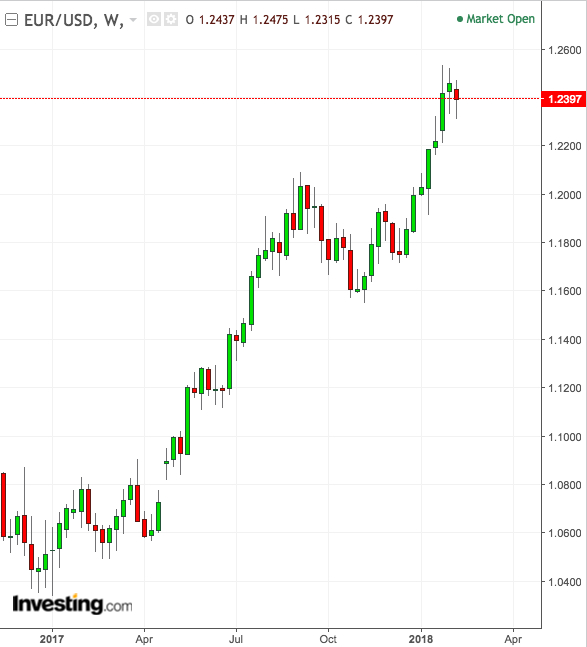- Among the positives: bottom line push for multinationals and exporters, increased tax revenue, U.S. job creation
- Among the negatives: weaker consumer spending, some firms hit via trade, higher fuel costs, inflation worries
- Eyes on central banks for further dollar impact
Starting at the beginning of 2017, the dollar has been experiencing an extended period of weakness that last year erased 11.5% of its value against major rivals and an additional 2.6% so far in 2018.

Although a stronger dollar is generally considered to be beneficial for the U.S., a weaker greenback can also have positive effects.
Sales Abroad Give Bottom Line Push
Multinationals are apt to be the clearest logical beneficiary of a weak dollar. According to the latest available data from S&P/Dow Jones Indices, S&P 500 firms registered 43.2% of their total revenue from overseas in 2016. As companies make profits in foreign currencies, dollar weakness means a boost to the bottom line when those profits are translated to the functional currency in an earnings report or those monies are repatriated back to the U.S.
In a similar fashion, U.S. exporters have the option of becoming even more competitive in foreign lands as the weaker dollar makes their products more affordable or they simply increase their prices to domestic currency equivalents, which ultimately translates to higher profits as well.
Higher Tax Revenue, More 'Made In USA' Jobs
The American people can also benefit from the weaker dollar as the Internal Revenue Service steps in to take its share of those higher corporate taxes. Furthermore, U.S. firms could opt to keep more operations stateside. if the price of foreign goods and services increases due to the weaker dollar, ultimately leading to the possibility of more jobs for American workers if manufacturing and production is shifted back to the U.S.
Less Bang For Consumer and Corporate Bucks
However, a weak dollar also runs the risk of negative impact. Most obvious, the American consumer will see prices rise when traveling abroad as the bang for their buck is decreased via the exchange rate. Even inside the U.S. imports will become more expensive.
Along similar lines, American companies conducting trade beyond the border could see their bottom lines hit as input prices rise when the weaker dollar has to be exchanged for a stronger local currency.
And of course, while U.S. exporters will feel the benefit of a weaker dollar, those firms involved in the resale of foreign goods domestically will see the pinch as its costs increase.
Americans may also take a hit at the pump. Gas prices tend to hold an inverse relationship to dollar strength. The increased fuel costs will also be detrimental to firms involved in transport.
Dollar’s Future Hanging On Central Bank Battle
In a nutshell, dollar weakness can have both positive and negative effects, but the real threat would come if the weakness becomes too prolonged. A recent major concern for markets has centered on the fact that higher commodity prices and more expensive imports could drive inflationary pressures that would force the Federal Reserve to ramp up its tightening of monetary policy. An accelerated withdrawal from quantitative easing or an increased pace of interest rate hikes would also likely have a direct negative impact on stocks.
With the U.S. economy trucking along—the Atlanta Fed’s latest forecast projects growth of 4.0% for the first quarter—recent dollar weakness has been attributed to moves by other central banks. Of notable impact is the case of the euro (see chart below) which makes up nearly 60% of the weight in the basket of currencies used in the dollar index.

Even though the European Central Bank is clearly lagging the Fed in its own removal of accommodative policies, including its still ongoing asset purchase program and the hiking of rates from historical lows (of 0% for its target rate and a negative 0.4% for its deposit facility rate), hawkish speculation coupled with a strong economic recovery in the euro zone itself has been priced into the common currency versus the greenback.
Adding additional fuel to the fire, recent market “turmoil” had clamped down on expectations for further policy tightening in the U.S. Prior to Tuesday’s recovery in stock prices, Fed fund futures had cut the odds for the next Fed rate hike at the March meeting to nearly 60% from around 71% a week earlier, according to Investing.com’s Fed Rate Monitor Tool. More notably, markets had also taken the possibility of three Fed rate hikes in 2018 back off the table before Wall Street’s recovery on Tuesday, with the probability falling below the 50% threshold. However, the prior session’s positive stock market close pushed the odds back up to nearly 54% in very early trading on Wednesday.
With volatility in full swing, we get the impression that future moves in the dollar, in whatever direction, will hinge less on economic data and more on the markets’ impression regarding where the Fed and ECB plan to take their respective monetary policies.
